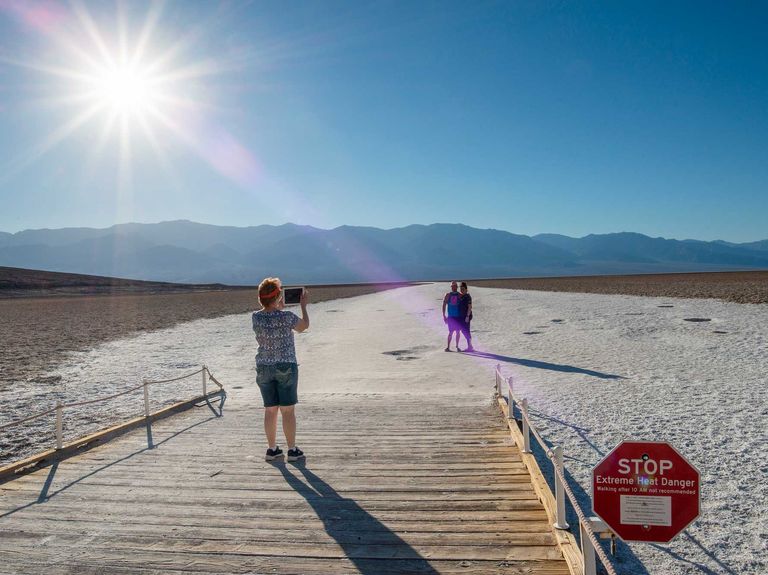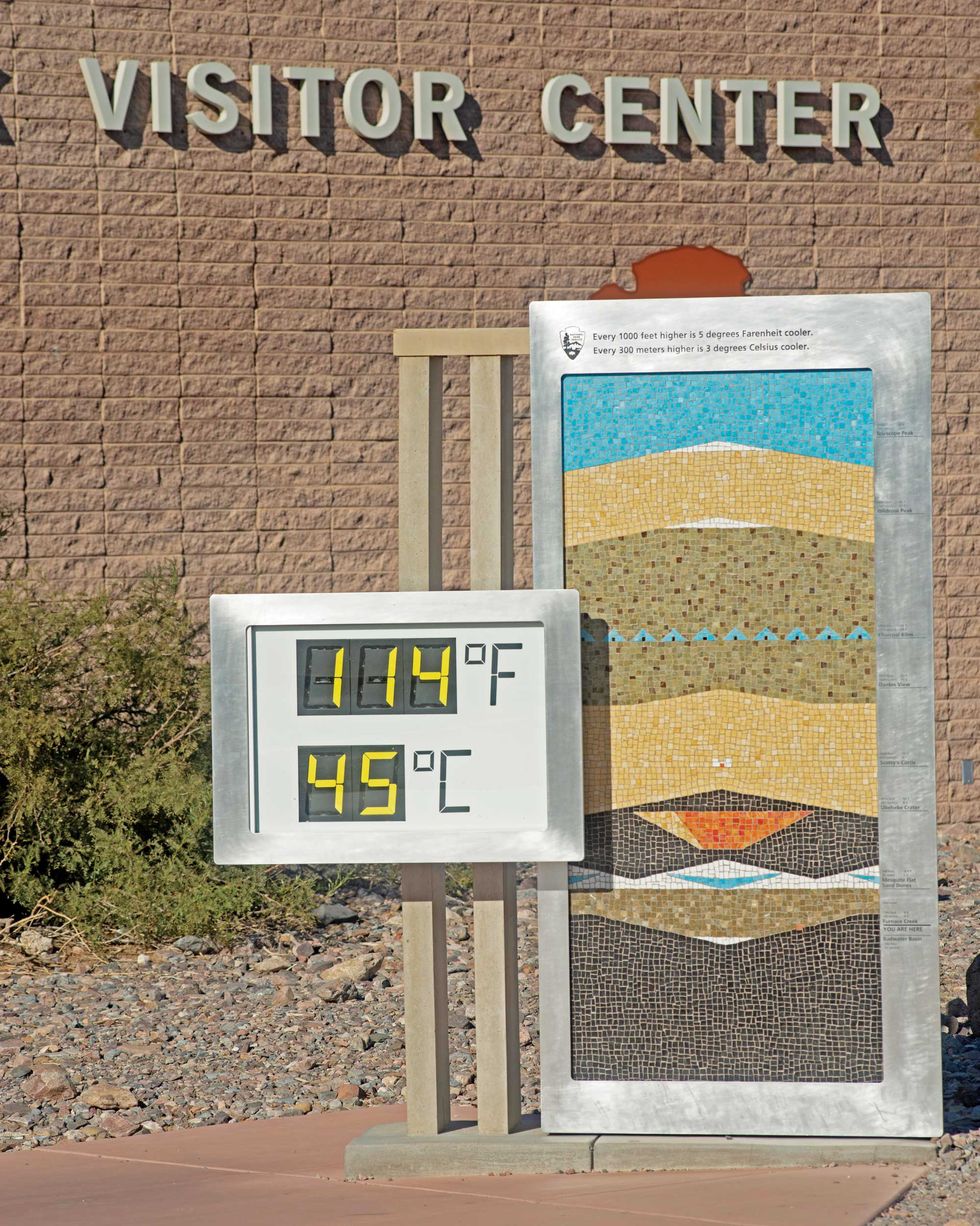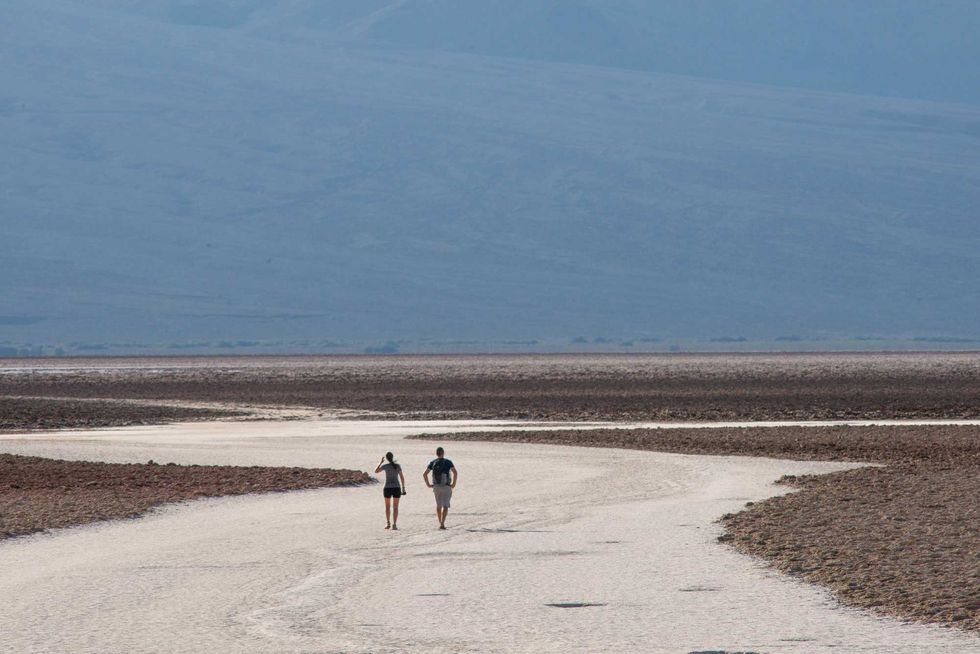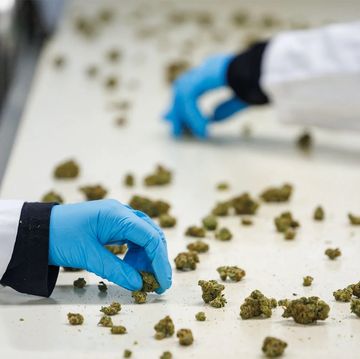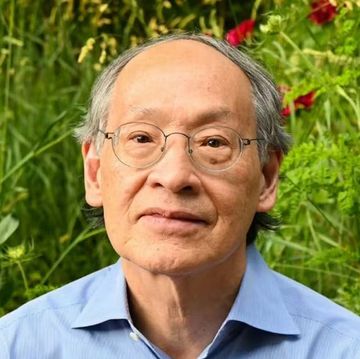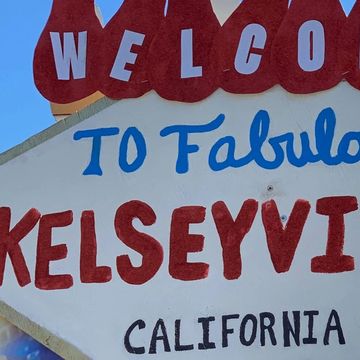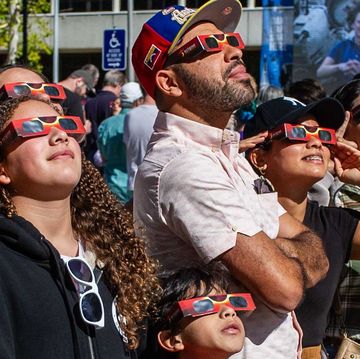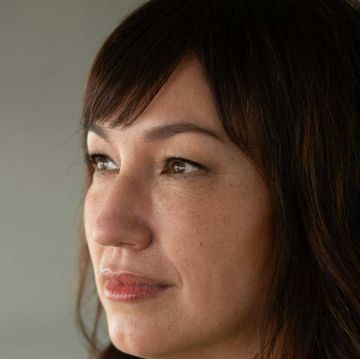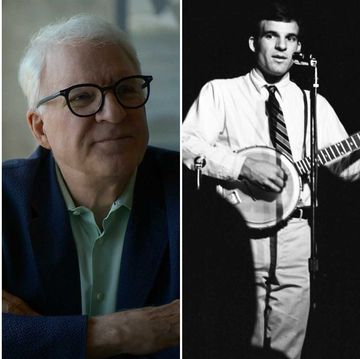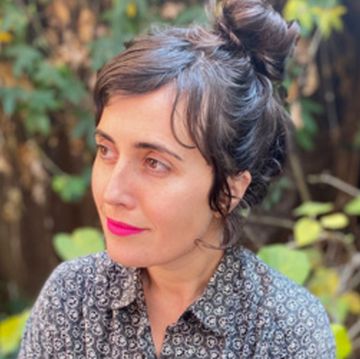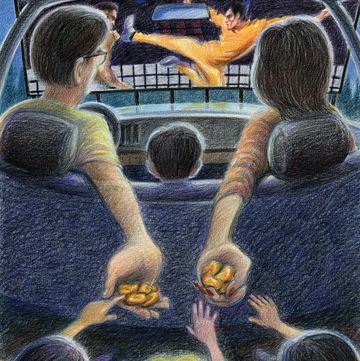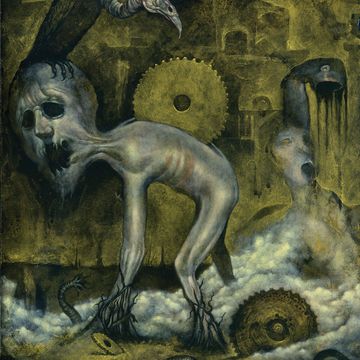The heat pounded everything, baked the creosote and desert holly nearly lifeless. It baked the pale clouds still, baked their shadows into the ancient hard hills below. The men and women around me were undeterred. On they walked, a German couple in matching visors leading the way. A Belgian readied his camera. Sweaty hands gripped water bottles. And then there it was, that which lures people onto airplanes and onto tour buses and out here into gorgeous hell: a thermometer.
Mounted outside the Furnace Creek Visitor Center, the instrument registered a relatively brisk 111 degrees Fahrenheit that day. But the mere possibility that it could go higher was enough. One by one, they stepped up for photos with it.
Like wildebeests trudging off to Masai Mara each year, a distinct breed of tourist makes this summertime Death Valley pilgrimage. They come from Austria, Japan, the Netherlands, France, Italy, Germany—fine and reasonable places whose utter pleasantness leaves a certain itch unscratched. The itch compels them to see what the planet is truly capable of, perhaps to see what they themselves are capable of—and, of course, to gather a few million pixels of proof.
Since becoming “Death Valley,” these 3.4 million acres have been not just a place but a dare—a taunting, vaguely Barnumesque seduction luring travelers to test their mettle amid some of California’s most extreme geology, its most extreme solitude, and, most thrilling, its most extreme climate. The valley’s record high of 134 degrees Fahrenheit may be enough for a medium-rare porterhouse, but to a certain mind it’s a siren song. Forbidding enticements abound everywhere online, from “11 Death Valley National Park Attractions for Daredevils” to “Badwater, Hell’s Gate, Desolation Canyon…do you dare go there?”
My encounter with the temperature tourists was a few years ago, and in the time since, something has begun to shift. That extreme climate, that demented dare: What happens when the rest of the planet starts to feel like that too?
Kids. Work. Marriage. Our crumbling democracy. Whatever human drama you hold, Death Valley obliterates it. It’s not just that the scale of this place dwarfs anything our species can come up with, although, sure, of course, it’s that, too. But a stranger force works on you here as well—some holy/unholy combination of the primeval palette, the eerie silence, and the incomprehensibility of the desert’s psychedelic time signature. You turn a little inside out.
It’s awful and it’s beautiful, which is to say it is sublime.
Not sublime like cheesecake but actual sublime: the exquisite terror of creation exceeding our internal capacity to grasp it. Some come here and dance, twirling the ineffable through sandstone canyons. Michelangelo Antonioni gestured at it in his 1970 film, Zabriskie Point. Five years later, the philosopher Michel Foucault lay out under the sky here for 10 LSD-fueled hours, listening to a recording of Richard Strauss’s Four Last Songs.
Of course he did, for nowhere is more fertile than the desert. To the searching heart, the desert is time itself; it is the null set; it is human solitude embodied. It’s the immense unknowability lurking under everything, and it’s “the search for something intimate in the remote,” per Edward Abbey.
Or anyway, that’s how it all was until nature lost its mind.
Perhaps you noticed. From record flooding in China to cold waves across the Midwest to Australia’s apocalyptic bushfires, climatological distress has cranked into fifth gear. Even the non-cataclysmic events are striking. As I write this, the ostensibly normal parts of California are recovering from a stunning heat wave: 112 degrees not far from San Francisco Bay, 110 in parts of Los Angeles. The numbers slipped back down, though not toward normal, as we have retired that quaint concept.
The extremes once embodied by Death Valley can now be found almost anywhere. A CNN analysis of National Oceanic and Atmospheric Administration data found that “at least 356 all-time heat records from California to Maine” were tied or broken between June and September 2022. A recent Reuters report revealed that the thermometer photography genre has caught on with Amazon drivers, who’ve taken to sharing pictures of temperature readings—many topping 120—inside their sweltering delivery vans.
Death Valley, in other words, has come to us.
To the extent that this place calls to mind an excitingly dangerous realm, we have good old 19th-century flair to thank. For hundreds of years, the Timbisha Shoshone inhabited these parts without getting particularly overwrought about the place. Then, in 1849, a contingent of pioneers intent on joining the gold rush opted for a shortcut they’d heard about. The so-called Lost ’49ers roamed the desert for several miserable months, starvation looming. When at last the party found their way out, someone in their midst supposedly turned back to issue a dramatic “Goodbye, death valley.”
This article appears in Issue 22 of Alta Journal.
SUBSCRIBE
The name didn’t just stick; it lit people up. Though only one of those pioneers had died in the valley, all manner of morbid lore took hold. This corner of the Mojave Desert remains inseparable from its purported danger. But surprise, surprise: visiting Death Valley is statistically safer than mowing your lawn. Despite being the largest national park in the contiguous United States—5,270 square miles of waiting calamity—it’s nowhere near the deadliest. (That’s the Grand Canyon, somehow still legal.) According to one delightfully macabre Outside magazine story, Death Valley ranks a lowly seventh when you factor in the number of tourists it receives: it sees 3.4 deaths for every million visitors. Most happen in ordinary car accidents.
I don’t mean to dismiss the allure of danger—I run my palm over a flame as much as the next guy. But planetary cataclysm strikes me as a fine time to pursue a more thoughtful relationship with our world. Why do we go in so hard for cartoonish notions of peril and “charismatic high temperatures,” as park spokesperson Abby Wines put it to me recently? What is that impulse, and what does it say about us?
Wandering around Death Valley, with its billion-year geology and aura of otherworldliness, I wondered whether cartoonish thinking is simply all we can muster. The first time a child sees an ocean, the roiling, fathomless scale of it short-circuits them. Unable to process the sheer magnitude and chaos of it, they latch on to something more manageable—a fascination with shipwrecks, or shark attacks, or the Mariana Trench. These, I suspect, are proxies for a vaster and more inconceivable truth about an ocean, a harder-to-pinpoint existential unease. Maybe it’s the same with Death Valley, those crazy-temperature photos a shorthand for something more profound and unsettling.
But there’s a distancing that comes with treating nature like an extreme sport, an opponent to be bested. This thinking others the planet, separates us from it. Wouldn’t we be in a better spot these days if we aimed for a more harmonious relationship with the earth? Fewer dares, more awe? At minimum, might we better understand the turbulent future barreling toward us?
Not long after the West Coast’s most recent heat wave, some friends of mine came to visit, and we set out on a minor road trip. To drive around California with out-of-towners these days is to slip, inevitably, into a Tour of Recent Climatological Drama. Over here is where the Russian River rose 34 feet in two days and flooded Guerneville. That’s where the Walbridge Fire nearly swallowed the grove at Armstrong Redwoods State Natural Reserve. This hill is where a Sausalito woman and her house and her cat traveled almost a block atop a churning mudslide.
In another era, maybe we would’ve torn off toward something wild and superlative—the state’s craziest massive mountain, our foggiest spot, our most ancient tree. But these friends had come from L.A., Texas, and New Jersey, all of which have been rocked by their own nature extremes lately. We parked above a pretty beach near Jenner and walked down to the sand.
As pelicans glided above, we just sat there, backs against a log. The air was finally cool, and whatever godless calamity awaited the Golden State remained at bay for the moment. I snapped some photos after a while—not of a thermometer blowing our minds, but of the thrilling and fleeting spectacle of everything being fine.•
Chris Colin’s work has appeared in The Best American Science and Nature Writing. He produces the podcast Longer Tables with José Andrés.
